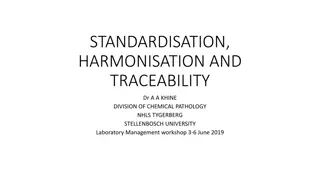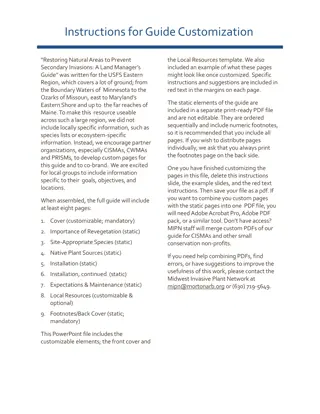Overview of Neisseria Species: Characteristics, Pathogenicity, and Laboratory Diagnosis
Neisseria species are Gram-negative diplococci known for pathogens like N. gonorrhoeae causing gonorrhea and N. meningitidis causing meningitis. They are aerobic to facultatively anaerobic, oxidase-positive, non-motile, and encapsulated cocci. N. gonorrhoeae is fastidious, requiring increased CO2 tension for growth. Diagnosis involves Gram staining, urine tests, and swab samples for identification.
Download Presentation

Please find below an Image/Link to download the presentation.
The content on the website is provided AS IS for your information and personal use only. It may not be sold, licensed, or shared on other websites without obtaining consent from the author.If you encounter any issues during the download, it is possible that the publisher has removed the file from their server.
You are allowed to download the files provided on this website for personal or commercial use, subject to the condition that they are used lawfully. All files are the property of their respective owners.
The content on the website is provided AS IS for your information and personal use only. It may not be sold, licensed, or shared on other websites without obtaining consent from the author.
E N D
Presentation Transcript
Genus: Neisseria spp. (Gram -ve; Oxidase +ve diplococci)
Neisseria spp. Gram s negative Diplococci Kidney shape with flat opposing edge
Neisseria spp. PATHOGENIC: N. gonorrhoea (gonococci, G.C) Gonorrhoeae. N. meningitidis (meningococci) meningitis. NON-PATHOGENIC: N. Catarrhalis Normal flora of upper respiratory tract
General characteristics of Neisseria spp. Aerobic to facultatively anaerobic Gram ve cocci Arrange in pairs (diplococci) with adjacent sides flattened (like coffee beans) Neisseria meningitidis whereas Neisseria gonorrhea is not Oxidase +ve / catalase +ve Non motile / non hemolytic is encapsulated
N. gonorrhoeae (gonococcus) Very delicate and fastidious, requiring increased carbon dioxide tension (3% to10%) for cultivation. Narrow optimal temperature range, between 35 and 37 C and fails to grow much above or below these temperatures. it may remain viable in dried pus for several weeks.
N. gonorrhoeae Diagnosis: Swab sample. A swab sample from the part of the body likely to be infected (cervix, urethra, penis, rectum, or throat) can be sent to a lab for testing: 1-Gram stain: A sample from the urethra or a cervix is placed on a slide and stained with Gram stain. The cells appear as Gram negative cocci form masses with adjacent cells (i.e. in diploid forms),having a bean-shape, a coffee bean- shape, or Kidney-shape. These cells are seen intracellularly (inside polymorphonuclear leucocytes), or extracellularly.
Laboratory Diagnostic Gram stain : G ve, diplococci Intracellular &/or extracellular in polymrphonuclar cells. Gram s staining slide for urethral discharge
2-Urine test. Gonorrhoea in the cervix or urethra can also be diagnosed with a urine sample sent to a lab. 3-Oxidase Test - It is a hallmark test for the Neisseria. The oxidase test determines the presence or absence of cytochrome C. Organisms containing cytochrome C as part of their respiratory chain are oxidase positive and turn the reagent purple; organisms lacking cytochrome C as part of their respiratory chain do not oxidize the reagent, leaving it colorless within the time limits of the test, and are oxidase negative.
Laboratory Diagnostic 4-Culture Pathogenic fastidious need chocolate agar +5-10% CO2 , selective media Selective media for Neisseria A. Thayer Martin Medium (TM) : ( Chocolate agar + Enrichment element +Antibiotics : 1. Colistin (against G ve rods) 2. Vancomycin (against G + ve) 3. Nystatin (against fungi) B. Modified Thayer Martin: {same as TM + Trimethoprim (against G ve especially swarming proteus)}. white-gray colonies (N. gonorrhoea on chocolate agar)
Candle jar 5%CO2
Neisseria meningitidis (Meningococcus) Meningococcus is similar to the gonococcus in morphology and staining reactions. Neisseria meningitidis is Gram-negative diplococcal bacterium fastidious in growth requirements and may be cultivated on blood agar or chocolate agar on which it develops relatively large, gray, smooth, raised colonies. No hemolysis is produced on blood agar. Neisseria meningitidis is the Causative agent of meningococcal meningitis, meningococcemia, and bacterial endocarditis. It is an obligate human pathogen.
Diagnosis: Specimen: The gold standard of diagnosis is isolation of N. meningitidis from sterile body fluid. Blood, CSF specimen is sent to the laboratory immediately for identification of the organism. It may be isolated from nasopharynx, joint fluid, and from petechiae of the skin. 1. Gram stain: show adjacent coffee bean-shape, Gram negative cells (diplococci) with flattened surfaces facing each other. 2. Culture: culturing the organism on Thayer-Martin agar. 3. Oxidase test: (all Neisseria show a positive reaction)
4-Sugar fermentation tests: important in differentiation between Neisseria. carbohydrates; maltose, sucrose, and glucose test in which N. meningitidiswill utilize the glucose and maltose. -ve +ve - ve +ve +ve - ve Carbohydrate fermentation set for Gonococci Carbohydrate fermentation set for Meningococci
DIFFERENTIATION OF THE NEISSERIAE Different Neisseria species can be identified by the sets of sugars from which they will produce acid. For example, N. gonorrheamakes acid from only glucose, however N. meningitidis produces acid from both glucose and maltose. Sugar fermentation Neisseriae Growth Characteristics Glucose Maltose Sucrose Lactose Growth on enriched media at 37 C in CO2 jar; colonies similar to N. meningitides, but smaller and grayish white _ N. Gonorrhea + _ _ Growth on enriched media at 37 C in CO2 jar; colonies smooth, glistening, translucent, soft, or bluish gray N. meningitidis + + _ _
Laboratory Diagnostic 5-Srology: determines the group of the isolated organism. If the organism reaches the circulation, then blood cultures should be drawn and processed accordingly. PCR; polymerase chain reaction tests can be used to identify the organism even after antibiotics have begun to reduce the infection
Thank you Thank you























